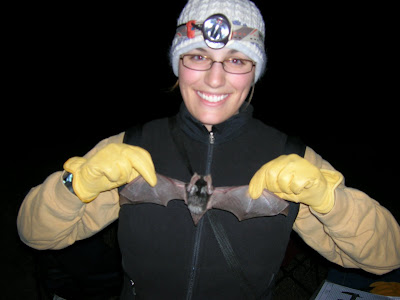
Might as well start off with the creme-de-la -creme of the bat species, since y'all have been deprived for a couple of weeks now.
Name: Euderma maculatum (hence my blog site: euderma.blogspot.com)
Common name: Spotted Bat, Skull Bat, and according to Wikipedia, the Jackass Bat
Merut's diagnostic characteristics:
- Long. long pink ears that slightly curve
- White belly
- Black back, with three large white spots, two on top, and one on the rump area - hence the "skull face"
- Truly one of the easiest bats to diagnose

Merut's Experience: This bat is "rare", meaning researchers rarely catch them, and they are not sure if that is because the species is rare, or they are just hard to net. Either way, the first Spotted bat I mistnetted, was on a night when all the other technicians were doing insect sampling, and I was netting with a couple of USGS folks. I took out the bat, immediately knowing what it was. The USGS dude said, "I hope you appreciate this. Most bat biologists will never see one. So don't tell them. They might be extremely jealous." So it was a proud moment for me. I have mistnetted 3-4, and seen about 5-6. So I'm very lucky. In terms of radio-tracking them, they are very difficult. The only one we could find was roosting in one of the sheerest areas of Mesa Verde, and therefore nobody could pinpoint the roost.

Other notes:
- Spotted Bats may be more common than previously believed
- Weighs 16-20 grams
- Wingspan is 13-15 inches
- Occurs in the desert, as well as open ponderosa pine woodlands
- Their echolocation is audible to humans (which is not true of all bats)
- They are a sensitive species in Utah



horrible. the bat doesnt look particularly comfortable in any of these pictures.
ReplyDelete